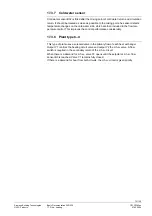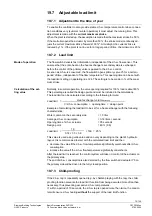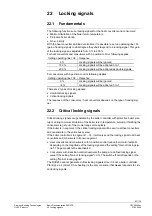
87/130
Siemens Building Technologies
Basic Documentation RVD230
CE1P2383en
HVAC Products
23 Function block Device functions
27.05.2004
Flow alarm:
ERROR
t
T
V
w
x
25
24
D
0
5
t
A
t
A
t
A
t
1
t
2
y
T Time
T
V
Flow
temperature
t
1
Start of ERROR display
w
Setpoint
t
2
End of ERROR display
x
Actual value
t
A
Waiting time (set on operating line 143)
Y
Setpoint band (setpoint ± 1 K)
•
At t
1
, an error message is triggered; during the period of time t
A
(set on operating line
143), the actual value stayed below the setpoint band y
•
At t
2
, the error message is reset; the actual value x has reached the setpoint band y
When the flow alarm function is activated, any flow or differential temperature sensors
(if present) may not be used for display since their signals are used for supervisory
functions.
23.4.2 Direct d.h.w. heating via heat exchanger
With plant types x–4, this function is required to detect faults on the primary valve and
primary actuator, faults that may pose a risk to the end-user. Hence, this function has
not
been introduced to monitor the performance of d.h.w. control but to monitor the
temperature!
The function will be activated when the current d.h.w. setpoint is exceeded by 10 K for
a period of 20 seconds.
The flow alarm is not active with direct d.h.w. heating.
The flow alarm appears on the display as ERROR and, on operating line 50, with error
code 123. In addition, relay K6 will be energized; it can thus be used to switch on a
monitoring device, for instance.
Flow alarm for overtemperature supervision:
ERROR
t
T
V
w
x
23
83
D
0
5
t
B
t
1
t
2
T Time
T
V
Flow temperature
t
1
Start of ERROR display
w
Setpoint
t
2
End of ERROR display
x
Actual value
t
B
Waiting time (20 s)
"Forbidden” range
With plant types x–4, this function is required to detect bottlenecks in the heat supply
from the district heat network. Undertemperature supervision triggers an error message
when – for a defined period of time during a demand for heat – the flow temperature
falls below the flow temperature setpoint by more than 10 K. This period of time can be
Overtemperature super-
vision
Undertemperature
supervision
















































